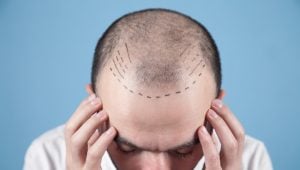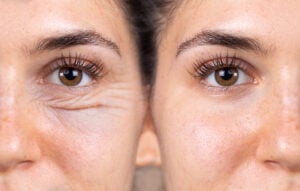Hair loss is a common problem that can damage people’s self-esteem. People worldwide, both men and women, will lose more hair than they expect, and possibly sooner. From the age of 35, about 40% of men start losing hair. By the age of 50, pattern hair loss affects about half of all men and a quarter of all women worldwide. This translates to about 35 million men and 21 million women in the USA. The prevalence of pattern baldness amongst men in the UK is the fifth-highest in the world at 39%. An indication of the distress this causes is that in 2017 the hair loss treatment market was worth 2.8 billion USD globally.
It is estimated that up to 73% of the general population suffer from AGA (Androgenic alopecia) or pattern hair loss in Asia. These patients have different family backgrounds to Europeans, so the type of hair loss and the best way to manage it may differ. For example, Japanese men develop hair loss about a decade later than Europeans, and it is less common, but its prevalence increases rapidly with age, as it does in Korea. Smoking also plays a significant role in hair loss. It is estimated that over 250 million people are struggling with hair loss in China alone, and it appears that hair loss is starting at an earlier age for the younger generation.
What is scalp micro pigmentation (SMP)?
Scalp micro pigmentation (also known as SMP) places pigment in the skin that looks like short or shaved hair. It creates a natural look of hairs coming through the scalp, even in bald areas. Cosmetic hair loss treatment providers use special equipment to introduce the pigment and choose from a selection of inks to match your skin and hair colour. The treatment is also described as a medical hair tattoo in some settings. The procedure is a highly advanced, non-surgical aesthetic solution to create a perfectly shaved look.
What is micro-blading?
Micro-blading and scalp micro-pigmentation are often used interchangeably, although they are slightly different. Both introduce pigment into the skin, not as deeply as tattooing, to represent natural hair. Scalp micro-pigmentation represents shaved or closely cut hair, whereas micro-blading represents single strands of hair. Scalp micro-pigmentation is often used for diffuse hair loss, where hair transplants cannot assist.
How is scalp micro pigmentation different from FUE hair transplant?
Follicular unit extraction (FUE) hair transplants are a popular surgical procedure amongst medical tourists, who often travel to places like Turkey to receive an affordable hair transplant. During the FUE procedure, hair follicles are transplanted from one area of the scalp to a balding area. When accompanied by short-term medical treatment, the FUE hair transplant procedure allows for hair to grow in the balding area.
Scalp micro-pigmentation is a non-surgical treatment rather than a hair transplant like the FUE surgical procedure. SMP creates the impression that hair has been shaved in the area. The procedure can also be used to fill in thinning hair areas, creating the illusion of thicker hair. Micro-blading can fill in gaps between thinning hair, especially around the scalp line, to create a fuller look for those who want to keep their hair.
What is the process?
Seeking a consultation with a skilled hair loss doctor is the best place to start. The treatment provider will determine the best approach for you, whether scalp micro-pigmentation, micro-blading or other options. Some practices can also perform a simulation of the result based on your photograph, so it is worth asking if this is available! Both procedures create the appearance of hair without surgery, and if you have some hair, you may be asked to shave before the procedure.
Micro-blading works best around the hairline framing the face, whereas scalp micro-pigmentation has a much broader range of applications, for shaved hair or buzz cuts and diffusing hair loss.
For scalp micro-pigmentation, a device with multiple 0.3-millimeter needles is used to embed microscopic dots of ink in the scalp, which creates a realistic appearance of hair follicles. During the first session, a lighter pigment is introduced, and the colour is adjusted in the second session to create a more natural appearance. A single blade or stylus is used to cut a fine line of ink into the skin for micro-blading, making the impression of a strand of hair with gel.
Sessions can take three to five hours each, and you will need two or three sessions over several weeks. Micro blading only the scalp line will take about two to three hours with a shorter touch-up session some weeks later.
How long do the results last?
Scalp micro pigmentation is a long term solution that can last up to ten years, with touch-ups after five years. Micro blading lasts about 12 to 18 months.
Is scalp micro pigmentation removable?
Micro scalp pigmentation is a permanent cosmetic hair tattooing treatment, though it may fade slightly over several years. However, you can have it removed with laser methods performed by a medical professional.
To avoid falling into regret, another cosmetic tattooing treatment option is a Tricopigmentation (STP) procedure. Tricopigmentation is a temporary medical hair tattoo treatment, and the inks used in tricopigmentation fade naturally in 12 to 18 months. This is a popular choice for patients who might want to trial the look of a medical hair tattoo before undertaking a permanent SMP solution.
Some noteworthy scalp micro pigmentation clinics around the world
Some of the leading clinics performing scalp micro pigmentation or micro-blading procedures include Scalp Micro USA in the USA, Skalp in the UK, Vinci Hair Clinic in the UK and worldwide, HIS Hair Clinic in the UK and Europe, MSP Clinic in Thailand and Scalp Center in South Korea.















